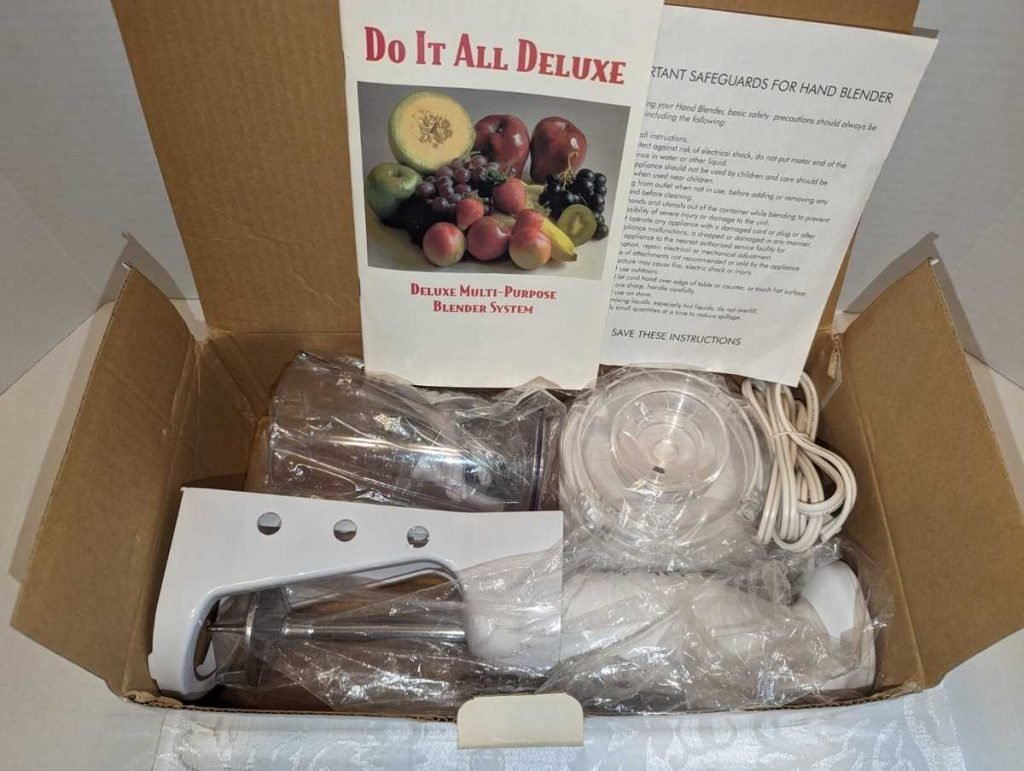To prevent overfilling and spillage in your blender, always leave some space at the top of the jar before blending. Use the correct amount of ingredients, secure the lid tightly, and blend in short bursts instead of continuous heavy blending. These simple steps can keep your kitchen clean and your blender working smoothly.
Overfilling and spillage are common issues that can make your blending tasks messy and frustrating. To avoid this, ensure you don’t fill the jar to the very top—leave enough space for ingredients to move around. Securing the lid tightly is essential to prevent leaks, especially when blending thick or icy mixtures. Additionally, blending in short, controlled intervals helps avoid sudden spills and ensures thorough blending. Following these tips can save you time and hassle, keeping your blending process clean and efficient every time.
Blenders are incredibly versatile and useful kitchen appliances, perfect for making smoothies, soups, and sauces. However, overfilling the jar or not properly securing the lid can lead to spills that create a mess on your countertop and waste ingredients. Whether you’re a beginner or a seasoned chef, learning how to prevent overfilling and spillage is key to getting the most out of your blender without the cleanup headache. By understanding the right amount of ingredients to add, ensuring the lid is tight, and blending carefully, you can enjoy a smoother, less messy experience every time.
How to prevent overfilling and spillage in blenders
Understanding the importance of proper filling techniques
Using your blender correctly starts with knowing how much to fill. Overfilling can cause messy spills and damage the motor. Properly filling your blender ensures smooth blending and keeps your kitchen clean. It also extends the life of your appliance by avoiding strain on the motor.
How much should you fill your blender?
Most blenders have a maximum fill line marked inside the jug. It’s best to fill the container only up to this line. Typically, aim for filling about two-thirds of the container. This provides enough space for ingredients to move around and blend properly without spilling.
Benefits of not overfilling your blender
Keeping your blender within recommended limits prevents spillage during blending. It avoids creating pressure that can cause leaks or damage. Additionally, it ensures ingredients blend evenly without overflowing, giving you a consistent mixture.
Factors that contribute to overfilling your blender
Several factors lead to overfilling, including adding too many ingredients at once. Using thick or dense ingredients increases the risk of spills. Also, rushing and not paying attention while filling can result in exceeding the limit.
How to measure ingredients accurately
Using measuring cups or a kitchen scale helps add the right amount of ingredients. This practice prevents overfilling and promotes consistent results. When blending liquids, fill only to the recommended level to avoid spills.
Tips for adding ingredients safely and efficiently
Start with small portions and add ingredients gradually. Use a spatula to scrape down the sides of the blender if needed. Avoid filling to the brim immediately; instead, add ingredients in stages.
Using the correct blender container size
Choose a container size that fits your batch size. For small recipes, a smaller jar prevents overfilling. Larger recipes benefit from bigger containers, reducing the chance of spills and overflows.
Understanding the role of lid security in preventing spills
Always ensure the lid is tightly secured before blending. A loose lid can cause ingredients to splatter or spill. Even a slight gap can result in a messy kitchen and potential damage to the blender.
How to properly secure the lid before blending
Place the lid firmly on the container, pressing down until it clicks or fits snugly. Check for any gaps or looseness. Some lids have a locking mechanism that helps keep them securely in place during operation.
Using tamper tools or pusher sticks to assist blending
When blending thick ingredients, use a tamper or pusher to guide ingredients toward the blades. This reduces the need to open the lid and prevents overfilling by controlling ingredient flow. Always follow your blender’s instructions regarding these tools.
How to avoid spills during liquid addition
Pour liquids slowly and steadily to prevent splashing. Use a funnel for narrow openings to control flow. Adding liquids gradually helps maintain the right fill level and prevents overflows.
Proper techniques for blending thick and frozen ingredients
Thick and frozen ingredients can cause pressure buildup. Blend in short pulses first, then continue with longer cycles. Add liquids in small amounts to keep the mixture flowing smoothly and prevent overfilling.
Managing blending speed and duration to prevent overflow
Start blending at a low speed and increase gradually. Monitor your mixture closely and stop blending if it starts to rise or spill. Avoid blending for too long, as this can cause heat buildup and spillage.
Monitoring the blending process for signs of overflows
Stay attentive to your blender during operation. If ingredients start to rise or foam excessively, turn off the machine. Adjust the ingredients or speed to prevent spills and maintain safety.
Cleaning up spills quickly and efficiently
If a spill occurs, turn off and unplug the blender immediately. Wipe the outside of the container and base with a damp cloth. Cleaning spills promptly prevents sticky residues and keeps your blender in top condition.
Regular maintenance and checks to prevent leaks and spills
Inspect seals and gaskets regularly for wear or damage. Replace any broken or worn parts promptly. Proper maintenance helps keep your blender functioning correctly and prevents leaks during operation.
Storing your blender safely to prevent accidental spills
Keep your blender stored upright in a safe place. Ensure the lid is secure when not in use to prevent accidental spills. Store accessories in a way that keeps them clean and undamaged.
Summary of key points for avoiding overfill and spillage
– Always fill your blender only up to the marked maximum line.
– Use the correct container size for your batch.
– Secure the lid tightly before operation.
– Pour liquids slowly and use funnels when necessary.
– Blend thick ingredients in short pulses and add liquids gradually.
– Monitor the process and stop if spillage begins.
– Regularly check and maintain seals and components.
– Clean spills promptly and store your blender safely.
By following these detailed tips, you can enjoy a clean kitchen, longer-lasting appliances, and perfectly blended recipes every time. Proper filling, safe handling, and regular maintenance are your best tools to prevent overfilling and spillage in blenders.
🌀 Blender Not Blending? Quick Fix in Minutes!
Frequently Asked Questions
What is the recommended maximum amount of ingredients to add to prevent overfilling?
To avoid overfilling, always adhere to the blender’s maximum fill line or capacity indication. Typically, filling the jar up to half or two-thirds of its capacity ensures there is enough space for the ingredients to mix properly without spilling. Overloading can cause ingredients to spill over, so it’s best to add ingredients gradually and monitor the level as you go.
How can I ensure ingredients stay within the blending container during operation?
Use smaller or evenly cut pieces of ingredients to prevent overflow. Secure the lid tightly before starting the blender, and avoid overloading the jar. When blending thick or dense ingredients, pulse the blender to control the mixing process and check the level frequently to prevent spillage. Adding ingredients gradually helps maintain a safe fill level.
Are there specific signs that indicate I am overfilling the blender?
Yes, signs of overfilling include ingredients reaching or exceeding the top of the jar, making it difficult for the lid to stay secure, or spilling out when blending begins. If you notice ingredients rising rapidly or spilling, reduce the amount of ingredients before proceeding. Always listen for unusual sounds or see excessive movement that suggests the mixture is too full.
What are effective ways to prevent spillage during high-speed blending?
< p>Start blending at low speed to prevent sudden splashes, then gradually increase to high speed once the ingredients are well mixed. Use a tamper or spatula to push ingredients down if your blender allows it, and never operate the blender without the lid securely in place. Keeping the ingredients below the maximum fill line ensures a cleaner blending process.
How should I handle thick or sticky ingredients to avoid overfilling?
When blending thick or sticky ingredients, add them in small portions rather than all at once. If your blender has trouble processing such ingredients, pause and scrape down the sides before resuming. Using less or thinner ingredients temporarily can prevent the mixture from expanding too much and causing spillage.
Final Thoughts
Properly filling your blender is key to avoiding overfilling and spillage. Always leave some space at the top to allow ingredients to blend smoothly. Use the maximum fill line as a guide to prevent overflow.
Secure the lid tightly before starting to blend to contain ingredients and reduce mess. For thicker mixes, pulse and stir manually to maintain control.
In the end, understanding how to prevent overfilling and spillage in blenders ensures safety and cleanliness. Maintain proper filling levels and secure lids for optimal blending.
As an Amazon Associate, We earn from qualifying purchases. When you purchase a product through Amazon links on kitchenadvising.com, we may earn a small commission at no extra cost to you. This helps support the site and keep our content free.


